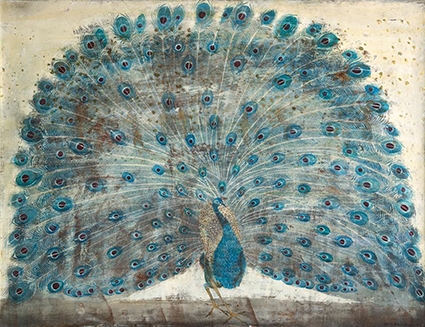As Wonderful as Art Can Be: Abramishvili’s Paradises, Panthers and More
As beautiful as art can be – these are the first words that come to my mind when I look at these magnificent works by Merab Abralishvili. People in general are inclined to either easily worship or easily criticize, and we, Georgians, people of extremities, are specially characterized by this feature. However, without any exaggeration, this stunning world will show you that sometimes even epithets are not enough. The Zurab Tsereteli Museum of Modern Art (MOMA) invites all who have even the slightest feel for perceiving beauty. This is an exposition that nobody should miss, that all Georgians and foreigners should see to get acquainted with the large scale of diversity that Georgian fine art possesses. Incomparable canvases performed in fresco technique have been displayed since March 9, and were to be taken down on April 3. However, due to the audience’s artistic appetite and good resonance, it will happily last until April 17.
The late Merab Abramishvili was a distinguished representative of modern Georgian art. His style represents an original transformation of Georgian cultural heritage, namely, Georgian frescoes, and is perceived as an extraordinary occasion not only against a background of Georgian art, but in the modern world art space as well. “We’ve exhibited his paintings regularly since 1992, when my gallery first opened,” Baia Tsikoridze, curator of the exhibition, told GEORGIA TODAY. “In 2013, I represented him at the London Sotheby Auction’s exhibitions ‘On the Crossroads 1 – Middle Asian and Caucasian Modern Art’ and ‘On the Crossroads 2 - From Istanbul to Kabul’. Abramishvili’s works were sold with success. The new catalogue is the most comprehensive that has been released so far, comprising around 400 paintings and this exhibition is the largest among those held in Georgia to date. I can tell you that 40% of his paintings are a total surprise – coming from private collections. This is an on-going process. Since opening this exhibition, new paintings have emerged.”
Levan Abramishvili, the renowned painter’s son, is a painter himself. He is very grateful to the organizers for completing such a tremendous task. “There are much more resources abroad in terms of exhibition space and a number of eager spectators. I can say that the maximum has been done considering the limited capacities of Georgia. Everything has been fulfilled to the highest level. Some of the paintings are from our family collection, whilst more than a half come from private collections. There were plenty of surprises for me and some works I had never seen before. I like my dad’s style very much, but I want to paint the way I want. My technique implies two pictures in one,” he told GEORGIA TODAY.
Merab Abramishvili graduated from the Tbilisi State Academy of Arts in 1981. His future aesthetics were influenced by medieval Georgian frescoes and Orientalist miniatures which were introduced to him by his father, Guram Abramishvili, an expert in Georgian medieval art at the Art Museum of Georgia. Impressed by the medieval frescoes from the Ateni Sioni Church, the artist adopted the gesso technique to create the texture of a mural in his easel painting. Due to his unique visual language and aesthetics, Abramishvili emerged as one of the leading Georgian artists to go beyond the established Soviet-era clichés. In the period of post-Soviet political instability, Abramishvili became preoccupied with mystical imagery. His works are displayed as part of solo and group exhibitions in both Georgia and abroad and are treasured by the Art Museum of Georgia and National Gallery of Art in Tbilisi as well as Museum Ludwig Cologne, and private collections in Finland and the United States.
The current exposition features the paintings created from 1985 to 2006, the year the painter died, and includes private collections from Georgia and overseas. There are negotiations to display this exhibition in foreign countries which will undoubtedly play a great role in the popularization of Georgian modern art. The very peculiar panthers and peacocks and interpretations on the motifs of paradise are captivating, as are the flowers adorned with half-surrealistic colors, giving the observer space to perceive and contemplate.
Apart from the catalogue, various products made according to Merab Abramishvili’s works are for sale in the museum shop, including reproductions on silk, postcards, notebooks, glasses and bags. Following the exposition, the catalogue will be available at Baia Gallery and various bookshops and museums.
Maka Lomadze











